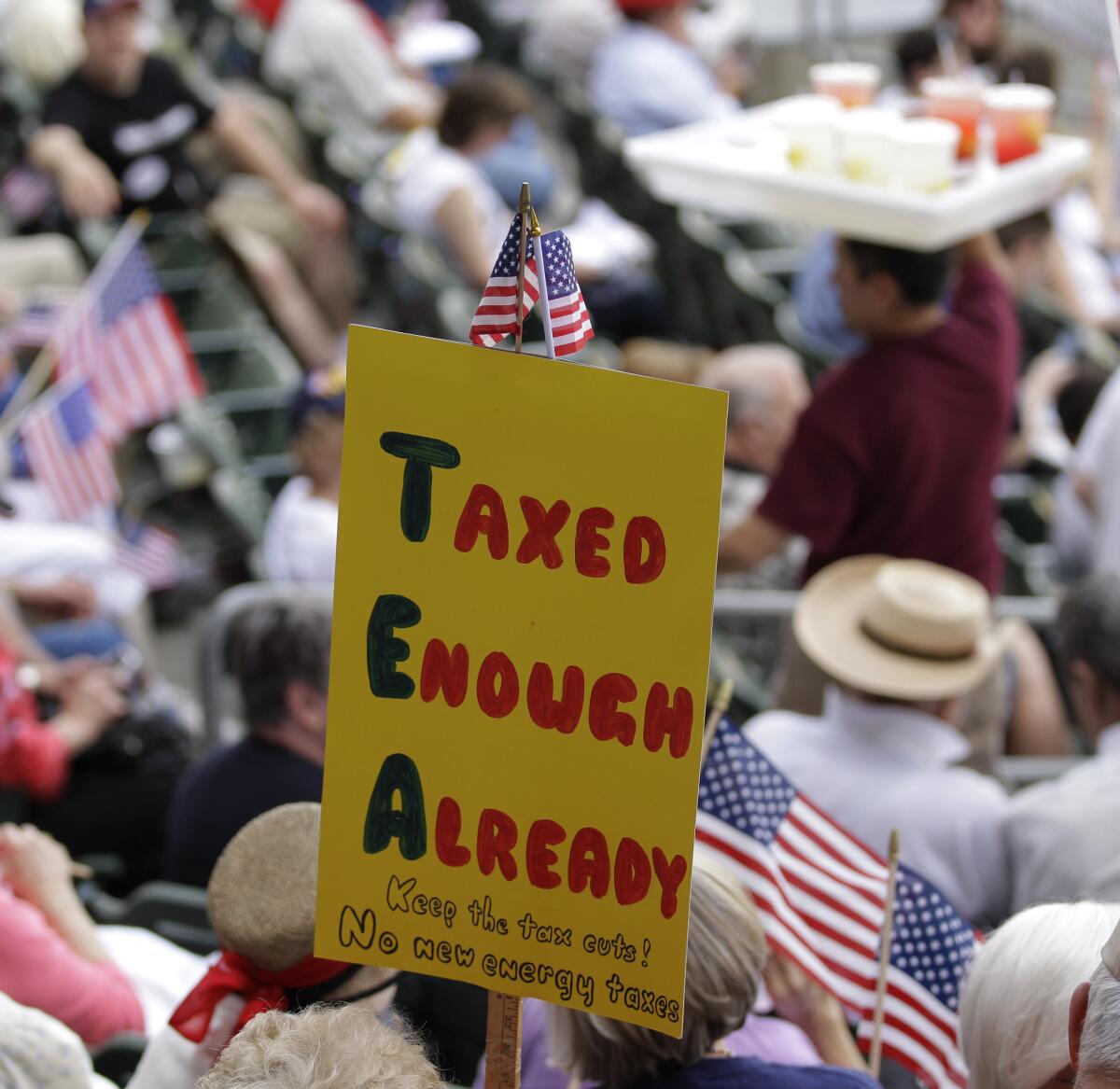Column: The nation is still hung over from the tea party. Don’t let 2022 midterms be a repeat

- Share via
There’s a Twitter game that routinely starts whenever a new, frightening revelation about the Trump administration becomes public: Clips of Hillary Clinton predicting that specific horror are resurrected. It’s really quite remarkable. From President Trump’s affinity for Russia’s Vladimir Putin to his refusal to accept the election results. (“Every time Donald thinks things are not going in his direction, he claims whatever it is is rigged against him,” she said in 2016 during the final debate between the two.) There are so many documented examples of Clinton’s warnings coming to pass that it’s easy to see why the 2016 election still takes up a lot of oxygen.
But the truth is, the nation began gasping for air in February 2010.
It started in a corner of New York state politics. For 13 years the 3rd Assembly District of eastern Long Island had been represented by Democrats. Then came L. Dean Murray. With the endorsement of Sarah Palin (then wildly popular) and the wind of anti-government sentiment at his back, this Republican candidate scored the 160-vote lead he needed to become the first tea party activist elected to office.
That body in a barrel that was found in Lake Mead won’t be the last crazy headline brought to us by climate change.
You remember the tea party, don’t you? The predominantly white, supposedly anti-big-government movement that was all fired up about the deficit once the first Black president was in the White House. Then Donald Trump shows up, hands out a $1.5-trillion package of tax cuts to the rich, grows the debt by the third-largest increase in history (behind George W. Bush and Abraham Lincoln), and Palin and company are behind him all the way.
Wonder why?
Anyway, Murray’s success was an indication of what was possible for the tea party. We don’t need to totally rehash the historic “shellacking” Democrats took in November 2010, do we?
It is important to at least remember that many of the recent state laws regarding reproductive rights, transgender student-athletes and voting are a byproduct of a tea party movement that gave Republicans six governors’ offices and flipped 21 statehouse chambers. Nearly 700 Democratic state legislators were moved out of office.
Will the fringe be able to keep the GOP congresswoman in office now that she has shown herself to be wildly unfit?
What did apathetic voters think was going to happen to progressive policies?
But it was when Eric Cantor lost in the primary (to the tea-party-backed David Brat) in 2014, becoming the first sitting House majority leader in this country’s history to lose a primary, that the remaining moderate Republicans fell in line. And they’ve been in line ever since.
Right, Susan Collins?
Sure, the tea party brand has lost pizzazz, but its influence can still be felt. And I don’t just mean the racist tropes that found new life during the Obama years.
Michael R. Pompeo, the former secretary of State who spent his last day in office tweeting that multiculturalism wasn’t an American value, was part of the tea party caucus. And remember that whole exploding deficit thing? Well, Mick Mulvaney, Trump’s director of the Office of Management and Budget, reportedly said “nobody cares” about it. He too was part of the 87 new House Republicans who stormed into office supposedly because Americans cared about the deficit.
Look, Clinton’s eerie foreshadowing aside, the point is the nation’s current ills didn’t begin because she lost in 2016. It was when roughly 45 million 2008 voters decided to sit out 2010. Check the receipts: That’s when President Obama’s agenda became handcuffed by obstruction; that’s when gerrymandering began to make more and more states look red; that’s how a Supreme Court justice gets denied a hearing and Roe vs. Wade becomes unsettled law.
Nearly 60,000 voted in that New York district in 2008, of which north of 30,000 supported the Democrat. But it was sexy to vote in 2008, wasn’t it? The history of it all. Then disillusionment quickly followed and by February 2010, a tea party activist in a predominantly Democratic district was sent to Albany after winning only 4,396 votes. Murray lost his seat in 2012, when turnout for the general was once again high, and then, as predictable as the trajectory of a pendulum, he regained it in the 2014 midterm when only 29% of registered voters participated.
Murray was elected even when he and the state Republican chairman admitted to hiring someone to attach a GPS device to the car of his Democratic opponent, Edward Hennessey, in a failed attempt to prove he didn’t live in the district.
Yes, Murray secretly put a tracking device on his political foe’s car and still won his district. That just feels like the kind of thing that voters shouldn’t find OK. Especially voters concerned with government overreach. What happened there is an indictment of the political sensibilities of his supporters and highlights the apathy that historically latches itself on to midterm elections everywhere.
And so here we are again, only this time we’re barreling toward a midterm while state governments are trying to force women to give birth against their will. It’s important … but will people see it as being as important as the presidential election? History says no, which is why turnout is typically significantly lower. And that’s what the conservatives want, as they are eyeing reproductive rights now and same-sex marriage later. For the midterm numbers to be low.
It seems conservatives — whether tea party or not — have figured out something most other voters continue to struggle to grasp: The stakes in these elections are high as well.
More to Read
A cure for the common opinion
Get thought-provoking perspectives with our weekly newsletter.
You may occasionally receive promotional content from the Los Angeles Times.













